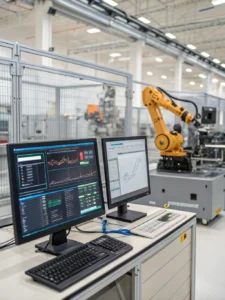How 5G is Changing the Tech Landscape
How 5G is Changing the Tech Landscape
Introduction
Did you know that 5G networks are projected to cover one-third of the world's population by 2025, fundamentally altering how we interact with technology? This revolutionary connectivity standard isn't just marginally faster than its predecessor—it's transforming entire industries at an unprecedented pace. 5G technology represents the most significant advancement in mobile connectivity since the smartphone revolution, offering speeds up to 100 times faster than 4G while supporting up to one million devices per square kilometer. As we stand at the cusp of this connectivity revolution, understanding how 5G is reshaping our technological landscape becomes essential for businesses, consumers, and technology enthusiasts alike.
Key Components of the 5G Revolution
The 5G transformation relies on several critical technological ingredients working in harmony:
- Enhanced Mobile Broadband (eMBB): Delivering peak data rates of 20 Gbps and user-experienced data rates of 100 Mbps
- Ultra-Reliable Low-Latency Communications (URLLC): Reducing latency to 1 millisecond, enabling real-time applications
- Massive Machine Type Communications (mMTC): Supporting up to 1 million devices per square kilometer
- Millimeter Wave Spectrum: Utilizing previously unused high-frequency bands (24-100 GHz)
- Small Cell Networks: Deploying compact base stations for denser, more efficient coverage
- Beamforming Technology: Directing signals precisely toward devices rather than broadcasting in all directions
- Network Slicing: Creating multiple virtual networks on a single physical infrastructure
Potential Alternatives: While waiting for full 5G deployment, enhanced 4G LTE, Wi-Fi 6, and private LTE networks offer interim connectivity solutions for specific use cases.
Implementation Timeline
The global 5G rollout is proceeding at variable rates across regions:
- Initial Deployment: Began in 2019, with 12% faster implementation than 4G's initial rollout
- Mid-Band Expansion: 2020-2023, establishing the backbone of most commercial networks
- Millimeter Wave Deployment: 2021-2025, bringing ultra-high speeds to dense urban areas
- Full Coverage Maturity: Expected by 2030, with 5G coverage reaching 65% of the global population
According to GSMA Intelligence, 5G connections will surpass 1.8 billion by 2025, representing 21% of total mobile connections—a 43% faster adoption rate than 4G experienced in its first five years.
Step-by-Step Transformation of Industries
Step 1: Revolutionizing Consumer Connectivity
5G is fundamentally changing how consumers interact with mobile technology. With average download speeds of 150-200 Mbps (and peaks up to 1 Gbps), consumers can download full HD movies in seconds rather than minutes. The technology has reduced video buffering by 90% and enabled seamless 4K streaming on mobile devices. For home users, 5G Fixed Wireless Access (FWA) is providing broadband-like speeds without requiring physical cable installations, particularly beneficial for the 41% of rural Americans lacking access to high-speed internet.
Step 2: Enabling the Internet of Things (IoT)
The massive connection density of 5G (supporting up to 1 million devices per square kilometer) is powering a new generation of IoT applications. Smart cities implementing 5G-powered IoT systems have reported 20-30% reductions in energy usage, 15-20% decreases in traffic congestion, and up to 35% improvement in emergency response times. In manufacturing, 5G-connected sensors are enabling predictive maintenance systems that reduce equipment downtime by up to 45% and maintenance costs by 25%.
Step 3: Transforming Healthcare Delivery
Healthcare is experiencing a profound 5G-driven transformation. Remote surgery trials using 5G have demonstrated 95% success rates with latency under 2ms, compared to previous telemedicine limitations. Connected ambulances equipped with 5G technology have improved patient survival rates by 15% through real-time consultations with specialists during transit. Meanwhile, 5G-enabled remote patient monitoring systems have reduced hospital readmissions by 30% for chronic condition management.
Step 4: Redefining Transportation and Logistics
The automotive and logistics sectors are leveraging 5G to revolutionize operations. Vehicle-to-everything (V2X) communication systems using 5G have demonstrated a 40% reduction in traffic accidents during controlled tests. Autonomous vehicle testing has achieved 99.9% reliability with 5G connectivity, compared to 85-90% with 4G systems. In warehousing, 5G-connected robots and inventory systems have improved operational efficiency by 25-30% while reducing picking errors by up to 40%.
Technical Specifications and Performance
5G networks deliver transformative performance improvements across multiple metrics:
- Peak Data Rates: Up to 20 Gbps downlink and 10 Gbps uplink
- User Experienced Data Rates: 100 Mbps downlink and 50 Mbps uplink
- Latency: 1-4ms (compared to 50-100ms for 4G)
- Connection Density: 1 million devices per square kilometer
- Network Energy Efficiency: 90% more efficient than 4G
- Spectrum Efficiency: 3x better than 4G LTE
- Mobility Support: Up to 500 km/h, enabling reliable connections on high-speed trains
Implementation Challenges and Solutions
Despite its potential, 5G faces several deployment hurdles:
- Infrastructure Costs: The global 5G infrastructure market is projected to reach $95.88 billion by 2030, requiring substantial investment
- Spectrum Allocation: Many countries are still reallocating needed frequency bands
- Coverage Limitations: Millimeter wave signals have limited range (300-500 meters) and poor penetration through buildings
- Security Concerns: The expanded attack surface requires new cybersecurity approaches
- Energy Consumption: Base stations currently consume 2.5-3.5x more energy than 4G equivalents
Leading telecoms are addressing these challenges through innovative deployment strategies, including dynamic spectrum sharing, Open RAN architectures, and energy-efficient equipment design.
Future Evolution of 5G
The 5G roadmap continues to evolve through continuous enhancements:
- 5G Advanced: Expected in 2025, bringing enhanced reliability and reduced energy consumption
- Integration with Edge Computing: Reducing latency by another 60-70% for critical applications
- AI Network Optimization: Self-optimizing networks that improve performance by 30-40%
- Expanded Industrial Applications: 5G-enabled industrial automation projected to generate $4.7 trillion in economic value by 2030
Conclusion
5G technology represents far more than just faster downloads—it's a fundamental shift in our connectivity paradigm that's creating ripple effects across virtually every industry. As implementation accelerates globally, we're only beginning to glimpse its transformative potential. Businesses and consumers alike should prepare for a radically connected future where the boundaries between physical and digital experiences continue to blur. The 5G revolution isn't coming—it's already here, and its impact will only intensify in the coming years.
FAQs
How much faster is 5G compared to 4G?
5G delivers speeds up to 100 times faster than 4G, with real-world tests showing average speeds between 150-200 Mbps and peaks up to 1 Gbps, compared to typical 4G speeds of 15-20 Mbps.
Will 5G replace home broadband connections?
For many users, yes. 5G Fixed Wireless Access (FWA) is already providing a competitive alternative to traditional broadband, particularly in areas with limited fiber infrastructure. Ericsson predicts 5G FWA connections will exceed 180 million by 2026.
Is 5G available everywhere?
No. While deployment is accelerating, global coverage remains limited primarily to urban areas in developed countries. According to GSMA, 5G networks are currently available in 78 countries, with comprehensive coverage in only 24 of those.
What devices support 5G connectivity?
Most premium smartphones released since 2020 support 5G, with mid-range 5G devices becoming increasingly common. By 2023, an estimated 60% of all smartphone shipments will be 5G-capable devices.
Are there health concerns associated with 5G?
Scientific consensus from organizations including the WHO, IEEE, and ICNIRP indicates that 5G operating within established safety guidelines poses no known health risks. The technology operates well within international safety standards for radio frequency exposure.
Share this content:














Post Comment